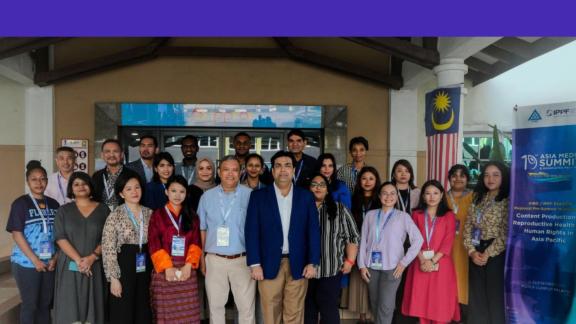In a rapidly shifting sociopolitical landscape where sexual and reproductive health, rights, and justice (SRHRJ) are increasingly contested, media professionals play a critical role in safeguarding democratic discourse and amplifying marginalised voices.
Navigating Sexual and Reproductive Health, Rights & Justice in Asia Pacific: A Practical Guide to Ethical Reporting & Content Creation for Media Practitioners, developed by the International Planned Parenthood Federation East, South East Asia and Oceania Region (IPPF ESEAOR) and the Asia-Pacific Institute for Broadcasting Development (AIBD), offers an essential framework for ethical, feminist-focused journalism in the Asia-Pacific region. This partnership brought together 50 media professionals from 17 countries across the Asia-Pacific region contributing to shaping this resource and making it a practical tool for journalists covering sexual and reproductive health, rights, and justice (SRHRJ).
when

“As reproductive justice faces unprecedented global challenges, the media’s role in fostering informed understanding and ethical discourse has never been more essential.” - Tomoko Fukuda, Regional Director IPPF ESEAOR

This guide responds to the growing threats posed by anti-rights actors who weaponise misinformation and target gender justice, reproductive autonomy, and LGBTQIA+ rights. With disinformation campaigns intensifying and restrictive policies resurging across the region, media professionals are urged to act as educators, monitors, mediators, and advocates. The guide outlines strategies rooted in human rights principles, prioritising safety, consent, equity, and inclusive representation.

“By strengthening the skills and knowledge of our members and the broader electronic media industry through strategic policy development, resource sharing, and hands-on training programs, we work to create a vibrant and cohesive media environment across the region.” -Philomena Gnanapragasam, CEO / Secretariat Director, AIBD

A SRHRJ media lens demands more than just reporting facts; it requires centering lived experiences and dismantling power structures that perpetuate gender inequality. Journalists are encouraged to avoid sensationalism and moral judgment, instead adopting survivor-centred, rights-based, and thematic approaches to coverage. Topics such as safe abortion, comprehensive sexuality education, and the criminalisation of sex work must be framed not only as public health issues but also as matters of bodily autonomy and social justice.
The guide also provides practitioners with tools to counter disinformation and navigate the complexities of cultural, legal, and political sensitivities without compromising integrity. It calls for a decolonised narrative approach, one that recognises historical injustices and amplifies local and community-led innovations in SRHRJ.
As we witness global democratic backsliding and rising hostility toward gender justice movements, this guide offers a path forward: one grounded in ethical storytelling, intersectional awareness, and feminist solidarity. Media has the power to inform, disrupt, and transform. This source equips journalists and content creators to challenge harmful norms, hold power to account, and contribute to a more just and inclusive society for all.











